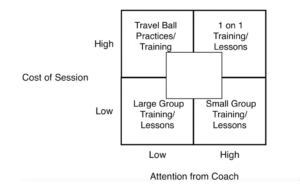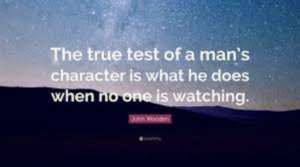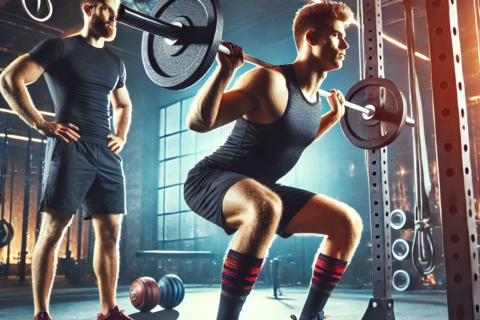The Why Behind The Semi-Private Training Model
Imagine this, you walk into a gym and notice athletes of all different backgrounds, sports, positions, ages, sizes, etc. all training at the same time. Sounds crazy? Hopefully not, but I wanted to highlight how we set up training at KPI.
We utilize a “Semi-private Training Model.”

What does this mean?
To understand this set up, I would like to provide some context on the different offerings you may or may not have heard of. We will start with the most common, 1 on 1 training/lessons.
This consists of one athlete working with one coach/trainer. The trainer/coach walks them through each step of their workout/session/lesson and it enables the player to get as much attention as possible. This is the most common set up for many skill related sessions, ie. pitching or hitting lessons.

The next set up is a small group training session/lesson. We categorize this as 1 coach to 5-10 athletes. The coach typically sets up the sessions as circuits or stations. The athletes all go through each of the stations before finishing the session. The set up of the session can look different than this but it’s typically what we see for small groups.

The last is large group training sessions/lessons. Large group is 1 coach to 10+ athletes. This can be a practice for a team, large group training in the weight room, or skill focused session with 10+ athletes. Similar to small group training, the coach will split the players up, they will work at a station or go through a circuit and complete each station before the session/lesson/practice is over.

There are pros and cons to each of these set ups. Before we go into them we wanted to create a graphic that highlights these.
So let’s highlight the pros and cons of each of the set ups.

There are many other pros and cons we could outline but on average these are ones families talk about. So back to the photo and the blank square. We didn’t put anything in that square because it doesn’t accurately represent the Semi-Private Training Model we utilize at KPI.
Semi-Private Training, defined by Toni Gentilcore, who credits Alywn Cosgrove is,
“Individual programs with a group of people (usually 2-4) training at the same time.”
One of the core principles of KPI is to take the best of something and replace/fix the crappy part. Many people believe that 1 on 1 training is the best way to go about developing a new athlete. That is why they pay extremely high rates to get it! We would like to present an argument for it not being the best way to train athletes for a few simple reasons:
Control
The secret to helping every athlete reach their goals is understanding their locus of control.
“Locus of control is the degree to which people believe that they, as opposed to external forces (beyond their influence), have control over the outcome of events in their lives.”
Everyone is driven by different things so taking the time to learn that as fast as possible with an athlete is crucial. We do this in our assessment process and provide a strong argument for the athlete being in control of a few very important things. It starts with how hard they are willing to work. We put it in the context that there are 168 hours in the week, how many of those hours are helping you get closer to your goals. The second is how hard are you willing to push yourself. Consistency is key when it comes to achieving goals, how far can you push yourself mentally to get there. Lastly, how much do you believe you will achieve your goals? Your mind can be your best friend or worst enemy, you are in complete control of your thoughts and you need to use them in a way that will get you closer to achieving them. Again, this secret isn’t much of a secret at all but I believe it starts with control.
Who is in control of me, “the athlete,” achieving my goals?
If an athlete feels that they are in control of this process, then they will take ownership of it and put the energy forth to achieve their goals. If they feel that it is outside of their control, they will only put energy forth when an outside force is making them. IE. your parents forcing you to go to practice, your coach making you do drills at a lesson, or your personal trainer making you do that one exercise you hate. We at KPI work to create an environment that enables all athletes to be in complete control of their process, know exactly what they need to do to achieve their goals, and give feedback with our data/reports on if they are getting closer or further away.
Motivation
Every person has things that motivate them. We break them down into two categories. The first is extrinsic motivation. This type of motivation is driven by an outside source. A coach, a parent, a peer, etc. Each of these outside influences can push a player to achieve their goals. The downside to extrinsic motivation is that once you remove the person or variable from the equation, motivation decreases.

This isn’t only true for men, well actually it might be. Most of our female clients crush training when no one is watching. But this is one of the biggest unspoken reasons 1 on 1 training isn’t the best option. Athletes are trained to only work on things with that coach. IE. I only work on hitting with my hitting coach, math with my math tutor, violin with my music teacher. We know that the people who are the most successful work all the time at perfecting their craft.
Intrinsic motivation is the second type of motivation. This is motivation that comes from within. The athlete is driven by internal reasons. This could be due to wanting to be the best, perfecting their skill, or it is enjoyable. It is a continual balance of both of these types of motivation and some extrinsic motivation can do an athlete good while less intrinsic motivation is happening but finding that balance and maintaining enough intrinsic motivation is key!
Competition
Last but not least is competition. All athletes have strong motivation to get better. This motivation gets stronger when they compete against themselves and other athletes. We create this culture by having it present in everything an athlete does at the facility, ie. our KPI Code, different hitting challenges in each cage, and bi-weekly reports on the metrics we know give athletes the best chance of success on the field. This is a tangible example of what is outlined above. Extrinsic motivation is beating other athletes in the moment or in the long run. While intrinsic motivation is shown by the athlete bettering themselves within our training environment and ultimately on the field. Competition is something that most athletes crave and we cultivate this by putting athletes of all levels, talents, and experiences into the same setting. Something that cannot be done in a 1 on 1 session as effectively as a semi-private session.
In summary, the semi-private training setting is something that we see as a huge competitive advantage! We know that athletes enjoy it more and see better results training this way. It is a compromise that we ask of parents and hope that the results speak for themselves. We can sum this up in one sentence.
“Athletes look forward to training in the semi-private environment.”
They aren’t forced to show up but choose to. Once that happens there are no limits to what they can achieve!


